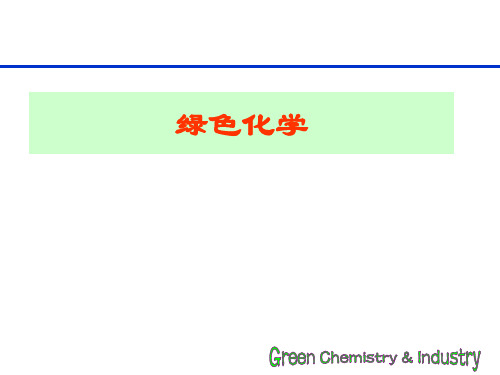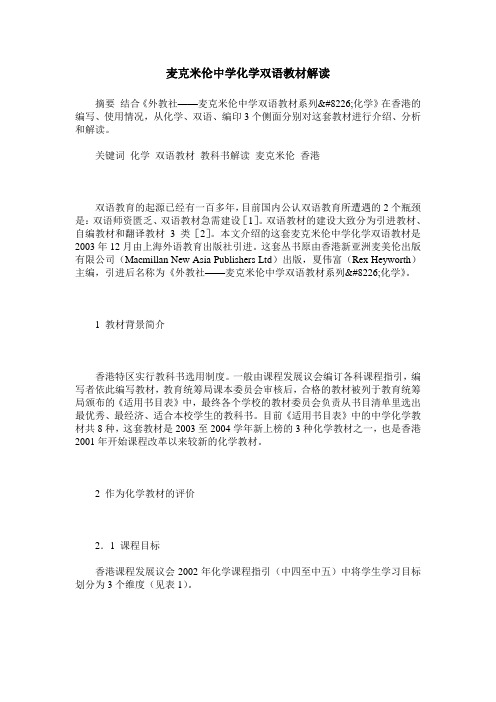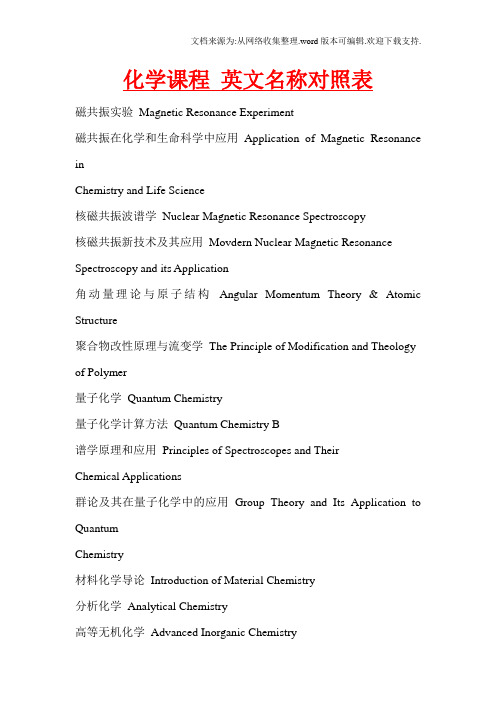最新化学双语教学-中学校本教材(英汉对照)
化学专业无机化学教材及主要参考书

化学专业《无机化学》主要参攻读物配套教材1、北京师大,华中师大,南京师大.无机化学(第四版) .北京:高等教育出版社.2003.1. (面向21世纪课程教材,获优秀教材一等奖,针对高等师范院校编写的教材,理论阐述深度适当,讲解清楚;并注意运用基本理论去解释无机物质的变化规律。
)2、申泮文.近代化学导论.北京:高等教育出版社.2002.1(面向21世纪课程教材,共有四部分: 基本化学原理;溶液平衡和化学分析;元素化学;近代化学热点。
)3 、武汉大学,吉林大学.无机化学(第二版).北京:高等教育出版社.(获国家优秀教材一等奖,高等教育出版社。
内容覆盖面较广,知识点讲解详细,条理清晰,有利于学生自学,有利于学生今后报考综合性大学研究生时,用做复习资料。
)4、傅献彩.大学化学.北京:高等教育出版社.1999.9(化学理科,面向21世纪课程教材,“九五”国家级重点教材,面向21世纪课程教材.将无机化学和化学分析的教学内容融合,上册以化学原理为主,将定量分析纳入化学平衡;下册以元素化学为主。
)5、天津大学.无机化学 (第三版).北京:高等教育出版社.2002.7(面向21世纪课程教材)6、史启祯.无机化学与化学分析(第二版).北京:高等教育出版社.2005.5.(1992年由教育部化学教学指导委员会立项, 列为国家“八五”重点教材.1998年由高教社出版, 2000年被列为国家“面向21世纪课程教材”)7、唐宗熏.中级无机化学.北京:高等教育出版社.2003.(普通高等教育“十五”国家级规划教材,介于无机化学和高等无机化学之间的中级水平的无机化学教材。
系统介绍了现代无机化学所涉及的新理论、新领域、新知识和无机新型化合物。
)8、傅献彩.大学化学.北京:高等教育出版社.(面向21世纪课程教材.将无机化学和化学分析的教学内容融合,上册以化学原理为主,将定量分析纳入化学平衡;下册以元素化学为主)9、申泮文.无机化学. 北京:化学工业出版社. 2002.(面向21世纪课程教材. 编写者均为名校专家,以专题形式撰写无机化学的近代成就与发展现状,各专题选录文献水平为当代国际前沿。
高中化学校本课程教材《绿色化学》

绿色化学化工
1851年,印第安索瓜米西族酋长西雅图—《西雅图宣 言》; 1962年,[美] 蕾切尔· 卡逊—《寂静的春天》; 1972年,罗马俱乐部 [美] 丹尼斯· 米都斯 等—《增长 的极限》; 1972年,[美] 芭芭拉· 沃德,勒内· 杜博斯 —《只有一 个地球》; 1972年,[美] 巴里· 康芒纳—《封闭的循环》; 1975年,[英] 彼得· 辛格—《动物解放》; 1987年,“世界环境与发展委员会”—《我们共同的 未来》; 1991年,[美] 阿尔· 戈尔—《濒临失衡的地球》; 1992年,[美] 艾伦· 杜宁—《多少算够》; 1998年,[瑞士] 苏伦· 埃尔克曼—《工业生态学》。
• 3. 人类活动污染宇宙
人类在太空活动40年来,留在太空的垃圾如废弃卫星、 火箭残骸、爆炸碎片等已满布太空,数以百万计。这些高 速飘游的太空垃圾已成为危险的太空“飘流炸弹”,对在 轨道上运转的太空器造成了严重威胁。 1983年,苏联一颗核动力间谍卫星烧毁,反应堆中的 110磅放射性铀有80%被释放出来,使高层大气中的放射性 最强的铀235含量增加了50%。 由于实验的需要,越来越多的地球生物进入太空。这 些进入太空的生物,在受到强烈紫外线和宇宙射线的照射 后发生突变,可能成为具有强烈毒性的生物。
绿色化学化工
• 3. 《寂静的春天》
1962年,美国科学家卡逊女士发表《寂静的 春天》,以通俗的笔法,提醒世人警惕过度使用农 药的恶果。
《寂静的春天》像是黑暗寂静中的一声呐喊, 唤醒了广大民众。
绿色化学化工
其他环保思想及经典著作
• 《人口原理》—— T.R.马尔萨斯 • • 1798年,T.R.马尔萨斯在《人口原理》一书中 根据资源有限,而人口按几何级数增长的情况,首 次提出人类应控制人口增长的思想。 • 北大校长马寅初教授在中国首次提出实施计划生育 国策。
初中化学双语教案

初中化学双语教案课题:原子结构Lesson Topic: Atomic Structure教学目标 Objectives:1. 理解原子的基本概念和组成。
2. 了解原子的结构及其不同部分的功能。
3. 掌握原子结构的基本模型和构成。
4. 能够描述原子内部的结构和不同部分之间的相互关系。
Teaching Aids: PowerPoint slides, textbook, whiteboard, markers教学过程 Teaching Procedure:Step 1: Introduction to Atoms- Begin the lesson by asking students what they know about atoms. Explain that atoms are the basic building blocks of all matter.- Show a visual representation of an atom on the PowerPoint slides and explain the different parts of an atom (protons, neutrons, electrons).- Discuss the concept of atomic number and atomic mass with the students.Step 2: Atomic Structure- Use the whiteboard to draw a diagram of an atom and label the different parts (protons, neutrons, electrons).- Explain the role of protons, neutrons, and electrons in an atom, and how they are arranged in the atomic structure.- Discuss the significance of the nucleus and electron shells in an atom.Step 3: Atomic Models- Introduce the different models of the atomic structure, such as the Thomson model, Rutherford model, and Bohr model.- Explain how each model contributed to our understanding of the atomic structure and the limitations of each model.Step 4: Activity- Divide the class into small groups and provide each group with a set of materials to build a model of an atom.- Instruct the students to work together to construct the atom model and label the different parts.- Have each group present their atom model to the class and explain how it represents the atomic structure.Step 5: Conclusion- Summarize the key points of the lesson and review the basic concepts of atomic structure with the students.- Encourage students to ask questions and clarify any misunderstandings they may have about atoms.Homework:- Ask students to research the contributions of different scientists to the development of atomic theory and write a short summary of their findings.教学反思 Teaching Reflection:本节课的教学目标是帮助学生理解原子的基本结构和组成,掌握原子结构的基本模型和构成。
【校本教材】高中化学校本课程教材:化学与食品化学

校本教材名称:化学与食品化学高中高中化学实施方案一、指导思想认真贯彻《基础教育课程改革纲要》的精神,结合我校“明理”教育特色学校创建,学校坚持以一切为了学生的发展为本,以兴趣性、拓展性为主,发展学生个性为主要目标,让课程适应学生的需要,有效促进学生的健康全面的发展。
根据学校的办学目标,充分利用学校现有的教学特色以及丰富的资源优势,认真做好校本课程的开发与研究,带动学校师资队伍建设与课程开发、管理、评价以及教学资源开发等方面的和谐发展。
充分利用学校的文化积淀、优厚的学校资源以及朱子故里丰富的图书资源与社区文化资源,引导学生继承、体悟和践履朱子理学中的伦理内蕴精髓,实现弘扬传统与培养学生社会主义核心价值观结合,打造“明理”教育特色学校,积极做好化学课校本课程的研究开发与实施工作。
二、实施目标要实现“以培养学生科学素养为主旨,激发学生学习化学的兴趣,帮助学生了解科学探究的基本过程和方法,培养学生科学探究能力”这一课程目标,必须在利用教材这一课程资源的同时充分开发化学校本课程以弥补教材的不足,推动素质教育的不断深化。
通过本次校本课程的研究学习,让同学们了解“生活中的化学”,在现实生活中,化学与之息息相关,可以说,我们每天都接触化学的有关内容,如衣、食、住、行都与化学有关,人们要创造美好幸福的生活是离不开化学的。
三、课程内容1.绿色化学——一种新的化学理念。
2.酸雨。
3.居室污染——生命健康的隐形杀手。
4.化学废旧电池的利用。
5.日用洗涤剂和人类健康。
6 .酒与健康。
7. 氢能——人类发展的历史性选择。
8. 环境。
四、开发原则本校本课程的开发设计的指导思想主要是依据新课标的教学理念,进一步提高学生的科学素养为宗旨,着眼于学生未来的发展,兼顾学生志趣与潜能的差异和发展的需要,以提高学生的科学素养为宗旨,激发学生学习化学的兴趣,尊重个性发展;帮助学生在已经获得知识的基础上解决问题的技能和方法,提高学生的科学探究能力;也培养学生的合作精神,提高学生的实践能力。
初中化学部分化学名词中英文对照归纳

litmus
高分子化合物
polymer
酶
enzyme
塑料
plastic
淀粉
starch
合成纤维
Synthetic material
油脂
fats and oils
合成橡胶
Synthetic rubber
蛋白质
protein
可降解塑料
Degradable plastics
氨基酸
amion acid
糖类
附:部分化学名词中英文对照化学名词的归纳
(1)化学反应类型名词中英文对照
中文
英文
氧化反应
oxidation reaction
还原反应
reduction reaction
化合反应
combination reaction
分解反应
decomposition reaction
置换反应
displacement reaction
初中化学部分化学名词中英文对照归纳
人教版九年级化学教材中共有化学名词中英文对照名词103个,可以将其分类整理归纳,形成系统性。在整理的过程中发现许多的名词很有规律。如化学反应类型中:氧化反应 oxidation reaction,还原反应reduction reaction,它们是“氧化oxidation”+“反应reaction”的形式。
复分解反应
uble decomposition reaction
(2)常见金属的名称中英文对照
铝
aluminum
铁
iron
铜
copper
钛
titanium
(3)常见有机物的名称中英文对照
有机化合物
麦克米伦中学化学双语教材解读

麦克米伦中学化学双语教材解读摘要结合《外教社——麦克米伦中学双语教材系列•化学》在香港的编写、使用情况,从化学、双语、编印3个侧面分别对这套教材进行介绍、分析和解读。
关键词化学双语教材教科书解读麦克米伦香港双语教育的起源已经有一百多年,目前国内公认双语教育所遭遇的2个瓶颈是:双语师资匮乏、双语教材急需建设[1]。
双语教材的建设大致分为引进教材、自编教材和翻译教材3类[2]。
本文介绍的这套麦克米伦中学化学双语教材是2003年12月由上海外语教育出版社引进。
这套丛书原由香港新亚洲麦美伦出版有限公司(Macmillan New Asia Publishers Ltd)出版,夏伟富(Rex Heyworth)主编,引进后名称为《外教社——麦克米伦中学双语教材系列•化学》。
1 教材背景简介香港特区实行教科书选用制度。
一般由课程发展议会编订各科课程指引,编写者依此编写教材,教育统筹局课本委员会审核后,合格的教材被列于教育统筹局颁布的《适用书目表》中,最终各个学校的教材委员会负责从书目清单里选出最优秀、最经济、适合本校学生的教科书。
目前《适用书目表》中的中学化学教材共8种,这套教材是2003至2004学年新上榜的3种化学教材之一,也是香港2001年开始课程改革以来较新的化学教材。
2 作为化学教材的评价2.1 课程目标香港课程发展议会2002年化学课程指引(中四至中五)中将学生学习目标划分为3个维度(见表1)。
2.2 教材内容2.2.1 结构和章节这套教材共4册8本,每册学生用书配套1本教师用书(分别编号为1A、1B、2A、2B),供高中2年(4个学期)使用。
每册的结构大体可分为前言、课文和附录3大部分。
前言包括各项出版说明、目录、致谢以及如何用好本书的说明。
课文(4册总计)共8篇22章。
周课时4节,每节40 min,共192课时(128 h)来完成整个课程。
教材章节结构第一册1A第一篇物质的基础1元素;2原子结构和周期表;3化合物和混合物;4化学键;5结构、化学键和性质;第二篇常见金属6常见金属和合金的用途;7金属的活泼性;8金属的腐蚀和保护;第二册1B第三篇化学电池和电解作用9化学电池;10氧化还原反应;11电解;第四篇常见的酸和碱12常见的酸和碱;13容量分析;第三册2A第五篇化石燃料14化石燃料的用途;15燃料的燃烧;16使用燃料所引致的环境问题;第四册2B第六篇来自石油的重要产品17塑胶;18烷醇;19清洁剂;第七篇重要的工业产品20氮肥;21漂白剂;第八篇化学药品与健康22化学药品与健康。
化学课程英文名称对照表

化学课程英文名称对照表磁共振实验Magnetic Resonance Experiment磁共振在化学和生命科学中应用Application of Magnetic Resonance inChemistry and Life Science核磁共振波谱学Nuclear Magnetic Resonance Spectroscopy核磁共振新技术及其应用Movdern Nuclear Magnetic Resonance Spectroscopy and its Application角动量理论与原子结构Angular Momentum Theory & Atomic Structure聚合物改性原理与流变学The Principle of Modification and Theology of Polymer量子化学Quantum Chemistry量子化学计算方法Quantum Chemistry B谱学原理和应用Principles of Spectroscopes and TheirChemical Applications群论及其在量子化学中的应用Group Theory and Its Application to QuantumChemistry材料化学导论Introduction of Material Chemistry分析化学Analytical Chemistry高等无机化学Advanced Inorganic Chemistry高等有机化学Advanced Organic Chemistry结构化学Structural Chemistry结构化学Structural Chemistry无机化学Inorganic Chemistry无机化学Inorganic Chemistry无机及分析化学Inorganic and Analytic Chemistry无机及分析化学Inorganic and Analytic Chemistry物理化学Physical Chemistry物理化学Physical Chemistry物理化学Physical Chemistry物理化学Physical Chemistry物理化学Physical Chemistry仪器分析Instrumental Analysis仪器分析Instrumental Analysis仪器分析Instrumental Analysis有机化学Organic Chemistry有机化学Organic Chemistry有机化学Organic Chemistry有机化学Organic Chemistry量子无机化学Quantum Inorganic Chemistry量子有机化学Quantum Organic Chemistry植物生长与发育的化学调整Chemical Adjustment of Plant's Growth分析化学Analysis Chemistry分析化学及实验Analytical Chemistry and Experiment分析化学实验Experiment of Analytical Chemistry计算机基础(C语言) Computer Basis C Language普通物理学General Physics无机化学实验Experiment in Inorganic Chemistry无机化学实验Experiment in Inorganic Chemistry无机化学实验Experiment in Inorganic Chemistry无机化学实验Experiment in inorganic Chemistry物理化学实验Experiment of Physical Chemistry物理化学实验Experiment of Physical Chemistry物理化学实验Experiment of Physical Chemistry物理化学实验Experiment of Physical Chemistry仪器分析实验Experiments of Instrument Analysis有机化学实验Organic Chemistry Experiment有机化学实验Organic Chemistry Experiment有机过渡金属化学Organotransition Metal ChemistryX射线晶体结构分析Crystal Structure Analysis by X-ray电分析化学实验Experiment in Electroanalytical Chemistry分子发光分析Molecular Luminescence Analysis分子发光分析进展Advances in Molecular Luminescence Analysis 高分子材料化学Polymer Chemistry高分子材料研究方法Research Methods of Polymeric Materials高分子合成与分子设计Polymeric Synthesis and Molecular Design 高分子化学实验Experiment of Polymeric Chemistry高分子物理实验Experiment of Polymer Physics化学分离法Chemical Method of Separation化学计量学Chemometrics化学统计力学和应用Statistical Mechanics and Applications in Chemistry化学文献Chemical Document化学文献Scientific Literature in Chemistry化学文献Chemical Literature化学文献Chemical Literature Searching金属有机高聚物Metallic Organic Polymer近代电分析Electroanalytical Chemistry近代分离分析Analytical Separation and Chromatography近代光分析Modern Light Analysis配位化学* Coordination Chemistry配位化学选读Selective Topics on Modern Coordination Chemistry无机材料化学The Chemistry of Inorganic Materials无机材料实验Experiment in Inorganic Materials无机材料物理Polymeric Materials Physics无机合成与研究方法Synthesis and Research Methods for Inorganic Substance无机物研究法Research Methods of Inorganic Substance 无机元素化学Inorganic Elements Chemistry物化专门化实验Physical Chemistry Experiment物化专门化实验Physical Chemistry Experiment物化专门化实验Physical Chemistry Experiment物理有机化学Physical Organic Chemistry仪器分析选读Advanced Instrumentation in Chemistry有机分析Analysis and Structure Determination of Organic Compounds有机分析实验Organic Analytic Experiment有机合成Organic Synthesis有机合成化学Synthetic Organic Chemistry有机合成实验Organic Synthesis Experiment有机化学文献Document of Organic Chemistry专业英语(分析) Scientific English on Analytical Chemistry 专业英语(无机) Specialty English专业英语(有机) Subject English专业英语(物化) Chemistry English生物无机化学Bioinorganic Chemistry生物无机化学Bioinorganic Chemistry材料工程导论Introduction of Materials Engineering 环境分析化学Environmental Analytical Chemistry 界面化学Surface Chemistry应用电化学Applied Electronic chemistry荧光分析法Flueremetry普通化学General Chemistry普通化学实验General Chemistry Experiments。
化学校本课程教材

化学校本课程教材趣味化学实验课程说明你看见过胶冻能燃烧、无水有冰袋、消字密无痕、水下百花开等现象吗?你知道这是为什么吗?你想亲自来动手试一试吗?如果答案是肯定的,那么请你走进《趣味化学实验》这个小天地吧!在这些富有情趣的化学实验中,你不仅能复习巩固化学知识,而且能提高学习化学的兴趣和热情,丰富课外生活,锻炼我们的动手能力,最终增进化学科学素养。
《趣味化学实验》课程安排为十个课时的内容,涵盖了贴近学生生活以及现实所学内容的简单实验,以让学生更多了解化学在生活中的应用。
每个课时内容大致分为:背景知识、实验原理、实验用品、实验步骤、问题思考、相关以及扩展实验几大部分。
目录趣味化学实验一:制作“叶脉书签” (3)趣味化学实验二:模拟酸雨腐蚀岩石的过程 (5)趣味化学实验三:自制酸碱指示剂 (6)趣味化学实验四:化学“冰箱”与冰袋 (8)趣味化学实验五:指纹鉴定以及检验加碘食盐中的碘元素 (11)趣味化学实验六:水下公园 (14)趣味化学实验七:豆腐中钙质的检验 (16)趣味化学实验八:食物中常见元素的测定 (20)趣味化学实验九:铝器表面刻字以及制备可燃的“胶冻” (22)趣味化学实验十:合成香精 (24)趣味化学实验十一:消字灵的制作 (29)趣味化学实验一:制作“叶脉书签”制作原理:叶片的叶肉部分容易腐烂降解,而叶脉非常坚韧,能构成各种形状比如网状、扇形、弧形等结构,以支持叶片。
选取具网状脉的植物叶片,用氢氧化钠等碱溶液加热煮沸,可以水解掉叶肉等部分,仅剩下网状脉,再利用过氧化氢的强氧化性将叶脉漂白,一件精美的叶脉书签便制作成功了。
工具材料:(1)5-10%的氢氧化钠溶液,5%的过氧化氢溶液;(2)电热套、烧杯(多个)、瓷盘、旧牙刷、镊子、水彩色;(3)采摘新鲜的具网状脉的植物叶子,如白玉兰、杨树、白蜡等。
制作步骤:(1)实验前采摘新鲜的树叶(以白玉兰叶为佳),落叶也可择优选用,应注意采摘树叶时要爱护植物;(2)用电热套加热氢氧化钠溶液,直至沸腾;(3)选5—10片大小适合的树叶放进煮沸的碱液中,要不停地将叶子摁到水下,直至沸腾,保持沸腾10分钟;(4)不时地用镊子拿出叶子,用手感觉叶肉是否煮烂;(5)在瓷盘里加适量水,将已煮烂的叶片放到其中,用旧牙刷刷叶肉,刷时先刷正面,按从左向右,从叶柄向叶尖,从主脉向侧脉有序地刷,直至刷掉叶肉;再将叶片翻转,用同样的方法刷,直至只剩下网状脉;(6)将叶脉放到盛清水的烧杯中,洗去残渍;(7)将洗尽的叶脉放到盛有5%的过氧化氢溶液中,放置24小时;(8)24小时后,叶脉便被漂白,从过氧化氢溶液中取出叶脉,放到标本纸中压干、压展;(9)将红水彩放到培养皿中,用水稀释3倍,并用毛笔刷到叶脉上,然后晾干;(10)将已涂色的叶脉标本进行压膜,各人还可根据自己的爱好进行艺术处理,这样一个精美的叶脉书签就制作成功了。
- 1、下载文档前请自行甄别文档内容的完整性,平台不提供额外的编辑、内容补充、找答案等附加服务。
- 2、"仅部分预览"的文档,不可在线预览部分如存在完整性等问题,可反馈申请退款(可完整预览的文档不适用该条件!)。
- 3、如文档侵犯您的权益,请联系客服反馈,我们会尽快为您处理(人工客服工作时间:9:00-18:30)。
双语和双语教学简介双语的英文是“Bilingual”。
根据英国著名的朗曼出版社出版的《朗曼应用语言学词典》所给的定义是:A person who knows and uses two languages.In everyday use the word bilingual usually means a person who speaks, reads, or understands twolanguages equally well (a balanced bilingual), but a bilingual person usually has a better knowledge ofone language than of the other.For example, he / she may:a) Be able to read and write in only one languageb) Use each language in different types of situation, eg. one language at home and the other atwork.c) Use each language for different communicative purposes, eg. one language for talking aboutschool life and the other for talking about personal feeling一个能运用两种语言的人。
在他的日常生活中能将一门外语和本族语基本等同地运用于听、说、读、写,当然他的母语语言知识和能力通常是大于第二语言的。
举例来说:他/她可能:A) 使用一种语言来读和写;而用另一种语言来听,说。
B) 在不同的场合下使用不同的语言,如在家使用一种语言,在工作单位使用另一种语言。
C) 在不同的交际需要下使用不同的语言,如在谈论学校生活时使用一种语言,而用另一种语言谈论个人情感。
“双语教学”的定义根据英国著名的朗曼出版社出版的《朗曼应用语言学词典》所给的定义是:The use of a second or foreign language in school for the teaching of content subjects.Bilingual education programs may be of different types and include:a) the use of a single school language which is not the child’s home language. This is sometimes called an immersion program.home language when the child enters school but later a gradual change tob) The use of the child’sthe use of the use of the school language for teaching some subjects and the home language forteaching others. This is sometimes called maintenance bilingual education.c) The part ial or total use of the child’s home language when the child enters school, and a later change to the use of the school language only. This is sometimes called transitional bilingual education.能在学校里使用第二语言或外语进行各门学科的教学。
“双语教学”项目可以有不同的形式,包括:A) 学校使用一种不是学生在家使用的语言进行教学。
这种模式称之为:浸入型双语教学。
B) 学生刚进入学校时使用本族语,然后逐渐地使用第二语言进行部分学科的教学,其它学科仍使用母语教学。
这种模式称之为:保持型双语教学。
C) 学生进入学校以后部分或全部使用母语,然后逐步转变为只使用第二语言进行教学。
这种模式称之为:过渡型双语教学。
简言之,“双语”和“双语教学”的界定是:将学生的外语或第二语言,通过教学和环境,经过若干阶段的训练,使之能代替,或接近母语的表达水平。
在中国,双语教学是指除汉语外,用一门外语作为课堂主要用语进行学科教学,目前绝大部分是用英语。
它要求用正确流利的英语进行知识的讲解,但不绝对排除汉语,避免由于语言滞后造成学生的思维障碍;教师应利用非语言行为,直观、形象地提示和帮助学生理解教学内容,以降低学生在英语理解上的难度。
中国不象新加坡、加拿大、印度是一个双语国家,语言环境并不是中外并重,所以中国的双语教学环境决定了它的目的性,属于“外语”教学范畴,而不是“第二语言”的教学范畴。
中国的双语教学只能是上述界定中的“保持型双语教学”。
诺贝尔奖是以瑞典著名化学家、硝化甘油炸药发明人阿尔弗雷德·贝恩哈德·诺贝尔(1833-1896) Alfred Bernhard NobelAlfred Bernhard Nobel, founder of the Nobel Prizes and inventor of dynamite and other powerful explosive, was born in Stockholm, Sweden, on October 21, 1833. His father, Immanuel, was an inventor and engineer who made munitions (军火) and explosives. Most of Alfred's time was spent in Paris, where he studied chemistry.In 1867 Alfred invented dynamite. Eight years later he produced an even more powerful explosive called blasting gelatin (爆炸胶). Duringhis lifetime Nobel took out more than 300 patents.At his death in 1896 Nobel left $9,200,000 to set up a fund for the Nobel Prizes.The Nobel Prizes are given each year for the most important work in six categories: physics, chemistry, physiology or medicine, literature, peace, and economics. The economics award was established in 1969. The prizes averaged about $40,000 each.Four institutions award the prizes. Sweden's Royal Academy of Sciences give the awards in physics, chemistry, and economics. The Royal Caroline Medico-Surgical Institute (皇家卡罗林医学外科研究院) awards the prize in physiology or medicine. The Swedish Academy awards the prize in literature. A committee of the Norwegian parliament gives the prize for peace.A committee selects the people most deserving of the awards. The prize-awarding institutions make the final selections, which are announced each November. Presentation ceremonies are held on December 10, the anniversary of Nobel's death. The peace prize is awarded in Oslo, Norway. The other prizes are presented in Stockholm,Sweden. Most people consider that winning the Nobel Prize is the highest honor that can be achieved in certain particular fields of work.Nobel Prizes in Chemistry1901Jacobus Henricus van 't Hoff (Netherlands, 1852-08-30 - 1911-03-01)Discovery of the laws of chemical dynamics and of the osmotic pressure insolutions1994George A. Olah (USA, *1927)Carbocations1995Paul Crutzen (Netherlands, *1933)Mario Molina (Mexico, *1943)Frank Sherwood Rowland (USA, *1927)for their work in atmospheric chemistry, particularly concerning the formation and decomposition of ozone1996Robert F. Curl, Jr. (USA, *1933)Sir Harold W. Kroto (United Kingdom, *1939)Richard E. Smalley (USA, *1943)for their discovery of fullerenes1997Paul D. Boyer (USA, *1918)John E. Walker (United Kingdom, *1941)for their elucidation of the enzymatic mechanism underlying the synthesis ofadenosine triphosphate (ATP)Jens C. Skou (Denmark, *1918)for the first discovery of an ion-transporting enzyme, Na+, K+-ATPase1998Walter Kohn (USA, *1923)John A. Pople (United Kingdom/USA, *1925)to Walter Kohn for his development of the density-functional theory and to John Pople for his development of computational methods in quantum chemistry(GAUSSIAN computer programs)1999Ahmed H. Zewail (USA, Egypt, *1946)for his studies of the transition states of chemical reactions using femtosecond spectroscopy2000Alan J. Heeger (USA, *1936)Alan G. MacDiarmid (USA, *1927)Hideki Shirakawa (Japan, *1936)for the discovery and development of conductive polymers2001William S. Knowles (USA, *1917)Ryoji Noyori (Japan, *1938)for their work on chirally catalysed hydrogenation reactionsK. Barry Sharpless (USA, *1941)for his work on chirally catalysed oxidation reactions2002John B. Fenn (USA, *1917)Koichi Tanaka (Japan, *1959)for their development of soft desorption ionisation methods for massspectrometric analyses of biological macromoleculesKurt Wüthrich (Switzerland, *1938)for his development of nuclear magnetic resonance spectroscopy for determining the three-dimensional structure of biological macromolecules in solution2003Peter Agre and Roderick MacKinnon (both U.S.) for studies on channels in cellwalls近10年来的诺贝尔化学奖与高考试题集锦随着知识经济的兴起,21世纪综合国力竞争的焦点是高科技领域,是尖端人才的竞争。
